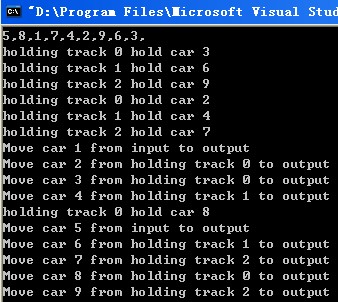
Look at figure 1. The railroad cars in the “Input track” is not sorted. We need them in a sorted way in “Output track” like cars in figure2.

There are three holding tracks we can use to rearranging roailroad cars. A picture is worth than a thousand words, so look at the gif picture below. You can see how the process acts.

So, how we use code to solve the problem? Here three holding tracks in the picture, so we can use three stacks to hold the number.
The Whole Code
// RailRoad.cpp : Defines the entry point for the console application.
//
#include "stdafx.h"
#include <iostream>
#include <stack>
using namespace std;
template <class T>
void PrintfNum(T a[], const int & n);
// move cars from holding track to output track
void OutPut(stack<int> t[],int n, int totalStack,int& min){
//move car from holding track
for(int x = 0;x < totalStack; ++x){
if(!t[x].empty() && t[x].top() == min){
cout << "Move car " << t[x].top() << " from holding track " << x << " to output" << endl;
t[x].pop();
++min;
x = -1; // find next car from the first holding track 0
}
}
}
// move cars from input track to holding track
bool Hold(stack<int> t[],int n , int totalStack){
for(int i = 0;i < totalStack; ++i){
if(t[i].empty() || (!t[i].empty() && t[i].top() > n)){
cout << "holding track " << i << " hold car " << n << endl;
t[i].push(n);
return true; // we already find a holding track, so break the loop.
}
}
return false;
}
int main(int argc, char* argv[])
{
const int NUM = 9;
const int STACKNUM = 3;
stack<int> t[STACKNUM];
int min = 1;
int a[NUM] = {5,8,1,7,4,2,9,6,3};
PrintfNum(a,NUM);
for(int i = NUM - 1; i >= 0; --i){
if(a[i] == min){// try to move cars from input track or holding track
cout << "Move car " << a[i] << " from input to output" << endl;
++min;
OutPut(t,a[i],STACKNUM,min);
}else{// move cars from input track to holding track
if(!Hold(t,a[i],STACKNUM)){
cout << "Not enough holding track" << endl;
break;
}
}
}
return 0;
}
template <class T>
void PrintfNum(T a[], const int & n){
for(int i = 0; i < n; ++i){
cout << a[i] << ",";
}
cout << endl;
}
While three holding tracks are sufficient to rearrange the cars from the initial ordering of Figure 1, other initial arrangements may need more tracks. For example, the initial arrangement 1, 9, 8, 7, 6, 5, 4, 3, 2 requires 8 holding tracks.
http://www.waitingfy.com/?p=508
508



[…] For You 记录一些关于android,objective-c,mfc,directX,c++,数学的东西 C++ Stack Example Rearranging RailRoad Cars 火车车厢重排问题 08 […]
This is a topic that is close to my heart… Best wishes! Where are your contact details though?